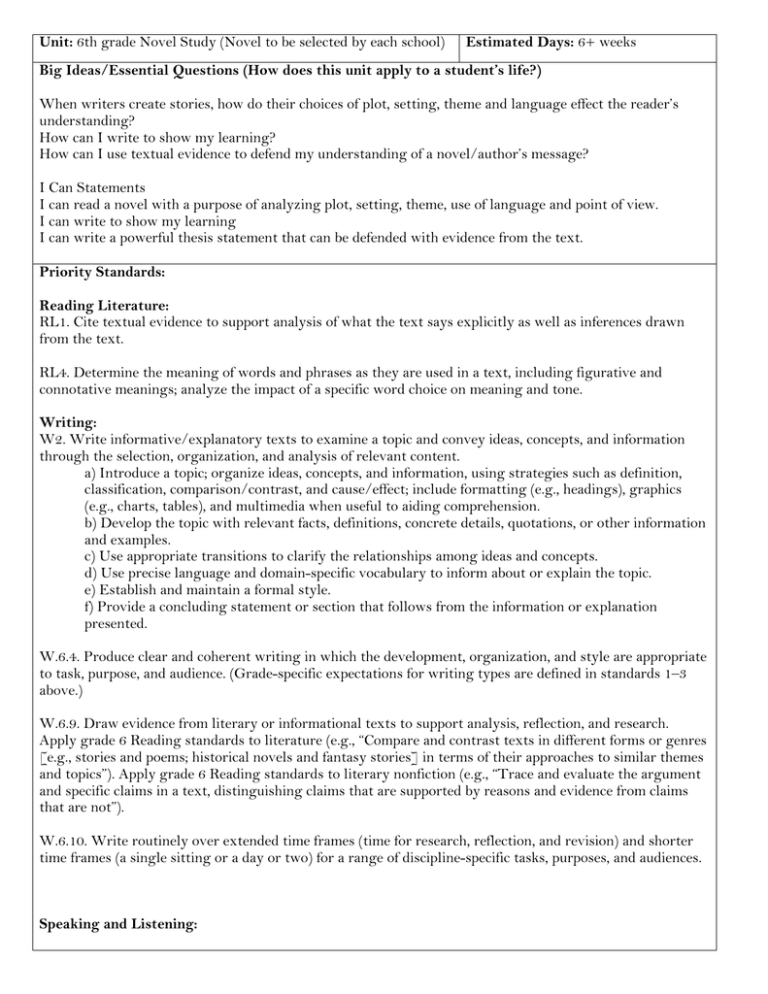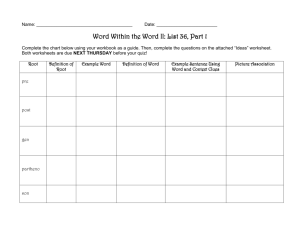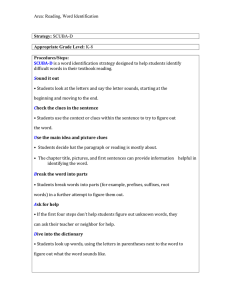Unit: Estimated Days:
advertisement

Unit: 6th grade Novel Study (Novel to be selected by each school) Estimated Days: 6+ weeks Big Ideas/Essential Questions (How does this unit apply to a student’s life?) When writers create stories, how do their choices of plot, setting, theme and language effect the reader’s understanding? How can I write to show my learning? How can I use textual evidence to defend my understanding of a novel/author’s message? I Can Statements I can read a novel with a purpose of analyzing plot, setting, theme, use of language and point of view. I can write to show my learning I can write a powerful thesis statement that can be defended with evidence from the text. Priority Standards: Reading Literature: RL1. Cite textual evidence to support analysis of what the text says explicitly as well as inferences drawn from the text. RL4. Determine the meaning of words and phrases as they are used in a text, including figurative and connotative meanings; analyze the impact of a specific word choice on meaning and tone. Writing: W2. Write informative/explanatory texts to examine a topic and convey ideas, concepts, and information through the selection, organization, and analysis of relevant content. a) Introduce a topic; organize ideas, concepts, and information, using strategies such as definition, classification, comparison/contrast, and cause/effect; include formatting (e.g., headings), graphics (e.g., charts, tables), and multimedia when useful to aiding comprehension. b) Develop the topic with relevant facts, definitions, concrete details, quotations, or other information and examples. c) Use appropriate transitions to clarify the relationships among ideas and concepts. d) Use precise language and domain-specific vocabulary to inform about or explain the topic. e) Establish and maintain a formal style. f) Provide a concluding statement or section that follows from the information or explanation presented. W.6.4. Produce clear and coherent writing in which the development, organization, and style are appropriate to task, purpose, and audience. (Grade-specific expectations for writing types are defined in standards 1–3 above.) W.6.9. Draw evidence from literary or informational texts to support analysis, reflection, and research. Apply grade 6 Reading standards to literature (e.g., “Compare and contrast texts in different forms or genres [e.g., stories and poems; historical novels and fantasy stories] in terms of their approaches to similar themes and topics”). Apply grade 6 Reading standards to literary nonfiction (e.g., “Trace and evaluate the argument and specific claims in a text, distinguishing claims that are supported by reasons and evidence from claims that are not”). W.6.10. Write routinely over extended time frames (time for research, reflection, and revision) and shorter time frames (a single sitting or a day or two) for a range of discipline-specific tasks, purposes, and audiences. Speaking and Listening: SL1. Engage effectively in a range of collaborative discussions (one-on-one, in groups, and teacher- led) with diverse partners on grade 6 topics, texts, and issues, building on others’ ideas and expressing their own clearly. a) Come to discussions prepared, having read or studied required material; explicitly draw on that preparation by referring to evidence on the topic, text, or issue to probe and reflect on ideas under discussion. b) Follow rules for collegial discussions, set specific goals and deadlines, and define individual roles as needed. c) Pose and respond to specific questions with elaboration and detail by making comments that contribute to the topic, text, or issue under discussion. d) Review the key ideas expressed and demonstrate understanding of multiple perspectives through reflection and paraphrasing. SL.6.3. Delineate a speaker’s argument and specific claims, distinguishing claims that are supported by reasons and evidence from claims that are not. SL.6.4. Present claims and findings, sequencing ideas logically and using pertinent descriptions, facts, and details to accentuate main ideas or themes; use appropriate eye contact, adequate volume, and clear pronunciation. SL.6.6. Adapt speech to a variety of contexts and tasks, demonstrating command of formal English when indicated or appropriate. Language: L.6.4. Determine or clarify the meaning of unknown and multiple-meaning words and phrases based on grade 6 reading and content, choosing flexibly from a range of strategies. a) Use context (e.g., the overall meaning of a sentence or paragraph; a word’s position or function in a sentence) as a clue to the meaning of a word or phrase. b) Use common, grade-appropriate Greek or Latin affixes and roots as clues to the meaning of a word (e.g., audience, auditory, audible). c) Consult reference materials (e.g., dictionaries, glossaries, thesauruses), both print and digital, to find the pronunciation of a word or determine or clarify its precise meaning or its part of speech. d) Verify the preliminary determination of the meaning of a word or phrase (e.g., by checking the inferred meaning in context or in a dictionary). Support Standards: Reading Literature: RL2, RL3, RL5, RL6, RL7, RL10. Reading Informational Texts: RI3 Writing: W5, W6 Language: L1, L2, L3, L5, L6. Content (students need to know): Skills (students need to do): How to define - Elements of Story Writing: How to identify character traits and development Develop a Thesis statement with an essay that cites textual evidence to build and support thesis. Create a Outline/SUTW Draft a 1st version Revise/Share with a partner Publish & Celebrate How to create an outline for a 5 paragraph essay How to read and re-read a portion of a novel to support at thesis How to respond to a prompt that has been given at with a topic sentence and supporting details. Increase their writing stamina Reading: Read with a Purpose: Target set by teacher Reading for Understanding: Sharing reading thoughts with others (partners, small group, participate in large group discussions) Reading Journals Read to Self, Read with a Partner, Read with Teacher and/or audio Summative Assessment(s) (evidence of learning): 1) Students will create an Essay that summarizes the Novel with an emphasis on defending a thesis statement. The thesis they create will need to be defended with examples and evidence based on character, theme, setting, plot, language/word choice, and point of view from the text. Students will cite information correctly within their essay. Thesis: _________________ is or is not worth reading. (Title of Novel) Note: Choice of writing rubric to be determined by PLCs. Factors to consider: SMARTER Balanced Writing Rubrics measure the Common Core Standards, however, at this time, anchor papers are not available. There is a separate SMARTER Balanced Writing Rubric for each type of writing. ODE Writing Rubric does not measure Common Core Standards, but anchor papers do exist. As far as addressing increased standards for rigor in writing, a score of 4 on the ODE no longer meets the standard. Scores of 5 or 6 would be required for meeting the current standard. 2) Student’s will be given the Context Clues 2-1 as a Summative Assessment for Word Meaning. Formative Assessments (evidence of progress): Suggestions: Reading Logs Reader’s Response Journals (connections, questions) – to include lower and higher levels of Blooms Taxonomy Discussions: Partner, Small Group & Whole Class - to include lower and higher levels of Blooms Taxonomy Filling out a plot map or sequence chart Entrance/Exit tickets What if students don’t get it? Interventions during the unit/mini lessons Resources: What if students do get it? Extensions during the unit/mini lessons Novel Sets by teacher or ideally by school Audio version of each novel CCS 4 point Informative-Explanatory Writing Rubric Context Clues 2-1 Assessment Document ( at the end of this unit plan)1 Resources Needed: Novel Sets by teacher or ideally by school Audio version of each novel Mentor Texts and Anchor Papers to model exemplar writing. 1 6/20/12 Palmer & Guttag _____________________________ Context Clues 2.1 Name: Directions: read each sentence and determine the meaning of the word using cross sentence clues or your prior knowledge. Then, explain what clues in the sentence helped you determine the word meaning. 1. Disdain: Everyone else at the party wanted pizza but Tim, who had a disdain for cheese. Definition: ___________________________________________________________________________ What clues in the sentence lead you to your definition? 2. Revamp: Grandpa didn’t know that Susie was coming along on the fishing trip, and now he had to revamp his plans. Definition: ___________________________________________________________________________ What clues in the sentence lead you to your definition? 3. Melodramatic: When Kiki got a tiny cut on her pinky finger, she got all melodramatic and began sobbing and demanding a doctor. Definition: ___________________________________________________________________________ What clues in the sentence lead you to your definition? 4. Contrition: As Tommy walked home with the money from the church he had stolen in his pocket, powerful feelings of contrition bubbled in his stomach. Definition: ___________________________________________________________________________ What clues in the sentence lead you to your definition? 5. Query: When the other moms heard about how Charlene had won the baking contest, her email box was flooded with queries for her award winning muffin recipe. A query is a question. Definition: ___________________________________________________________________________ What clues in the sentence lead you to your definition? 6. Gala: "Mom, I need new shoes if I am ever going to a gala event. What if anyone ever invites me to a wedding or a prom." Definition: ___________________________________________________________________________ What clues in the sentence lead you to your definition? 7. Earnest: Jeremiah joked around so much that when he told the others about the accident that had occurred, they didn’t believe that he was being earnest. Definition: ___________________________________________________________________________ What clues in the sentence lead you to your definition? 8. Jovial: Unlike Bob, who treated others rudely and kept to himself, Bobby was jovial, or friendly, and outgoing. Definition: ___________________________________________________________________________ What clues in the sentence lead you to your definition? 9. Demeanor: My grandma’s demeanor was such that people often thought she was being rude when she was just being honest. Definition: ___________________________________________________________________________ What clues in the sentence lead you to your definition? 10. Beckoned: The lady decided that it was tea time and so, by jingling a tiny silver bell, she beckoned her servants to attend. Definition: ___________________________________________________________________________ What clues in the sentence lead you to your definition? 11. Forlorn: With the field torn up by the players’ cleats, and the cold rain falling in waves, conditions on the playing field were forlorn. Definition: ___________________________________________________________________________ What clues in the sentence lead you to your definition? 12. Prodigious: Lula would have attempted the walk home, had it not been for the prodigious hill that stood between her and her destination. It would tire her out. Definition: ___________________________________________________________________________ What clues in the sentence lead you to your definition?





